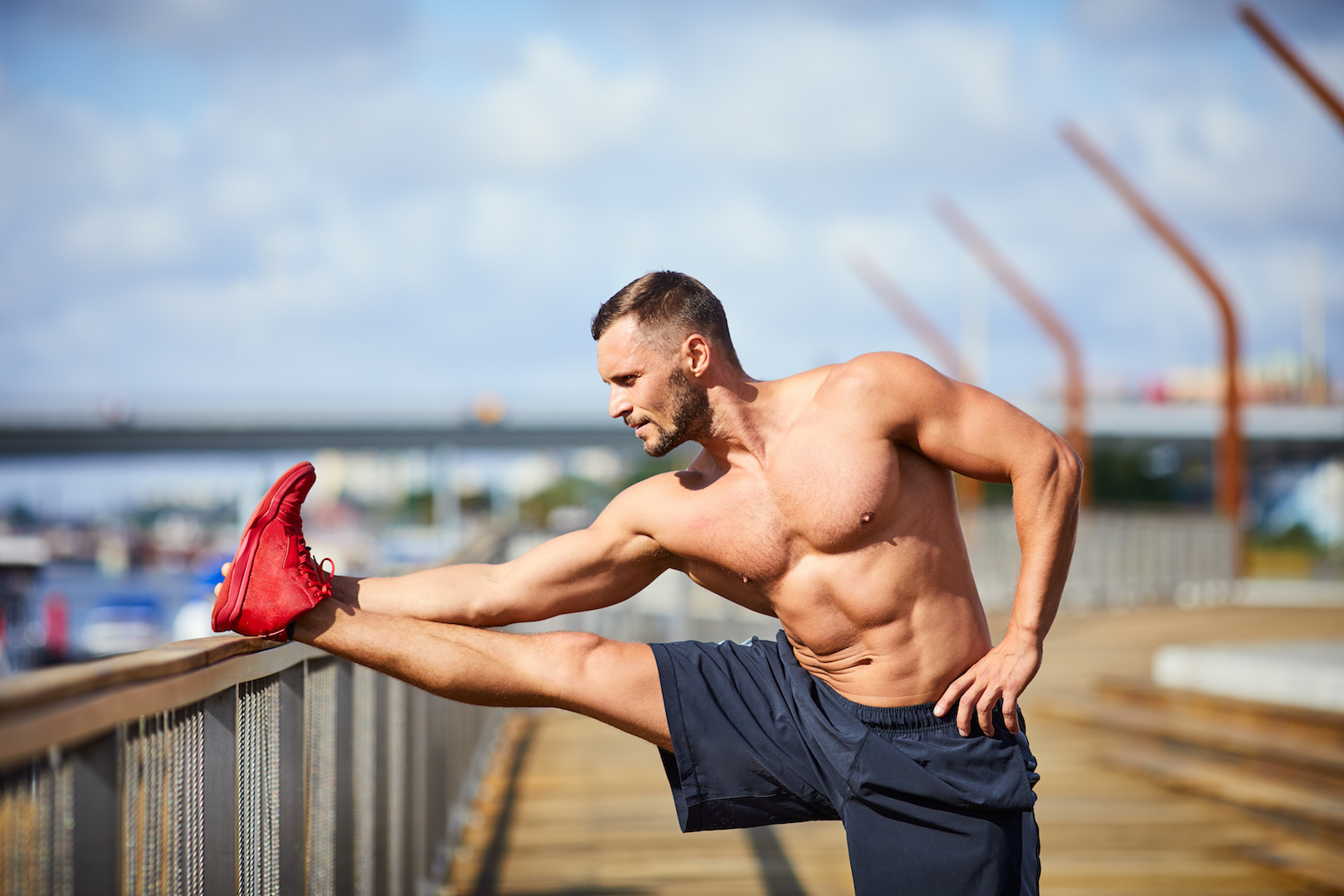Calf Stretch
The Best Exercise Warm-Up for Superb Gains
It is logical that if your warm-up stinks, so will your training. This article aims to clean the process, increase your chances of higher profits and maximize your performance. Let’s start by re-focusing on why we should warm up in the first place …
Published
5 years agoon
By
fitinstyle
It is logical that if your warm-up stinks, so will your training. This article aims to clean the process, increase your chances of higher profits and maximize your performance. Let’s start by re-focusing on why we should warm up in the first place …
Warm-up exercise: common denominators
While warming is a necessary constant, its specific strategies can vary quite a bit. However, whether you practice yoga or MMA, you are probably incorporating some of the same principles precisely for the same reasons.
Core temperature
Complete and appropriate warming increases the core body temperature. Even small increases in temperature seem to help with muscle flexibility, blood flow and joint fluidity. While raising the temperature alone is not enough to sufficiently prepare the body for performance, it is a vital part of the process. The simplest approach to meet this requirement is to perform any technique you choose up to, or a little further, the point at which you begin to perspire.
ROM
I often separate the range of motion (ROM) into three distinct areas: passive, active and functional. More specifically, to be able to pull a joint through a given range of motion using an external force or apparatus (passive ROM); being able to control a joint through a given range of motion without using an external force or apparatus (active ROM); and be able to control a joint during flexion / extension in other joints without using an external force or apparatus (functional ROM). ROM is greatly improved during warm-ups that involve the full range of motion that the athlete tries to perform. To satisfy this common denominator, perform heating techniques that involve the full ROM in the given joints that you plan to target.
Neuromuscular priming
Efficiency of movement is a hallmark outcome of proper warm-ups. With each rep performed, the body becomes better at activating the specific muscle groups in the specific movement pattern and sequence. However, be careful not to overextend toward exhaustion. While the athlete gets more efficient with each movement, there is a trade-off that comes with this expense of energy. To satisfy this common denominator, utilize the full movement pattern, timing, and (to some extent) force, while keeping as much energy in reserve as possible.
Psychological priming
Psychological priming starts the minute the athlete laces up and doesn’t end till performance is over. Techniques used to achieve this goal of warm-ups can get somewhat tricky. For this reason, I highly recommend minimizing the use of techniques that may be unfamiliar to the athlete before an actual competition. However, there is a school of thought that advises practicing harder than you play. This may involve warming up in novel and experimental ways before practices. To satisfy this common denominator, engage the in movements and strategies you’ve already mastered while adding elements of “new” to them, such as dynamic/unbalanced forces, verbal cues, etc.
Clean Up Your Routine with a Fresh New Approach
With the fundamentals in mind, lets add a level of “new” to our perspective that may breathe fresh life into this often overlooked, but incredibly important, part of our routine.
As noted earlier, different sports often employ different methods to achieve the same results. For example, an underlying goal of every warm-up routine ever performed is to enhance engagement by the athlete. However, enough repetition of any given routine may eventually fall victim to redundancy and, subsequently, disengagement. This redundancy does have a flip-side in sport, referred to when discussing flow, but all too often the recreational trainee may suffer from this redundancy more than reap its’ rewards.
For this reason, I’ve often used warm-up techniques from different sports to conscientiously engage otherwise disengaged clients and athletes. Even if only to revisit the “why” behind what we do, our routines might benefit by sampling strategies from other athletic approaches.
Some general techniques from different sports are noted below. I’ve categorized them by their common denominator mentioned earlier and aligned them top to bottom according to force production. Starting with the top left, and moving toward the bottom right, consider adding an element or two before maximal performance. In doing so, I guarantee you’ll start to see the warm-up for the performance enhancing strategy it was always intended to be.
Be wary, however, when introducing new elements to your warm-up. The goal is to engage – not overwhelm.
YOGA
Core Temp
Raising Room Temperature; Basic Muscle Contractions
ROM
Basic Movements; Advanced Movements with Blocks
Neuromuscular Priming
Muscle Contraction Coordinated with Sequenced Breathing
Psychological Priming
Rhythmic Sequences; Lighting; Smells; Music
RESISTANCE TRAINING
Core Temp
Incline Walk; Elliptical
ROM
Static Stretching; Dynamic Stretching;
Blended Stretching Techniques
Neuromuscular Priming
Technical Warm-Up Sets; Acceleration Techniques
Psychological Priming
Music; Self-Talk; Trainer Interaction
LONG DISTANCE CARDIO
Core Temp
Light Version of the Sport
ROM
Blended Stretching; Mobility Drills
Neuromuscular Priming
Repetitions in Place
Psychological Priming
Cadence; Music
SPRINTING
Core Temp
Light Version of the Sport; Warm Clothing
ROM
Blended Stretching Techniques; Mobility Drills
Neuromuscular Priming
Acceleration Techniques; Non-Fatiguing Plyometric Techniques
Psychological Priming
Self-Talk; Music; Coach Interaction
DYNAMIC SPORTS
Core Temp
Light Version of the Sport; Warm Clothing
ROM
Blended Stretching; Mobility Drills
Neuromuscular Priming
Multi-Directional Drills; Acceleration Techniques; Simulating Reactive Tasks
Psychological Priming
Cueing; Self-Talk; Team/Coach Interaction
Side Notes
If you feel the need to reinvigorate your warm-up (let’s be honest, we all probably should at some point), consider strategically adding a new element or two. In doing so, you may find fresh new life in an otherwise stale and dated routine.
You may like

Being flexible is vital for athletes in sports as well as anyone else who focuses on fitness. If your body is tight then you can’t perform at optimal levels and leave yourself vulnerable to injury. If you compete in an iron discipline like powerlifting, bodybuilding, or strongman, then you need to stretch so the fascia, which is the skin around muscle fibers, can open up and allow you to send more blood to the muscle. There’s no getting around it. You need to be stretching on a regular basis.
This concept should be familiar to anyone that had a basic PE class. Most coaches took their students through a very basic set of stretches before they began whatever activity was on the agenda for that day. These five stretches are basic but if you haven’t focused on flexibility and agility then it will be a good start for now. Do these same five stretches every day after a brief walk or warm up period. Make sure you never try to stretch a muscle before warming up. It won’t be as effective and can lead to injury. Perform each stretch twice for 20-30 seconds with 10 seconds in between each. You can also do this routine after training as a cool-down method if you like.

Calf Stretch – Place your feet on a step with your heels hanging off of it. Make sure you can maintain balance or support yourself by holding rails. Lower your heels as far as you can without coming off the step. Hold on to a rail or banister for balance. You should feel a stretch in your heels, calves, and up to your knees.

Touch the Toes – This is a simple one but it isn’t done as much as it should be. Keep your legs straight. Reach down to your toes or as far as you can. You should feel a stretch in the back of the legs up to the glutes. Maintain this stretch and continue to breathe while doing so.

Quad Stretch – Stand at a doorway and hold on to one side of it with your right hand. Pick up your left foot behind you like you’re attempting to kick yourself. Grab your left foot with your left hand. Pull and hold your foot until you feel a stretch in the front of your thighs. If you can’t reach your foot in this manner, place it on a bench or seat behind you and slowly squat down with the other leg until you feel that stretch. Repeat with the opposite leg.

Chest and Biceps Stretch – Stand in a doorway or rack and hold onto the back of it with your hands and arms straight. Push your chest forward until you feel a stretch in the chest and shoulder area. If you make a fist with your hands and hold them in the doorway you’ll feel a stretch in the biceps as well. Don’t try to stretch too hard or too far. You should just feel a mild discomfort, not pain.

Back and Arms Stretch – Grab a pullup bar with both hands. Allow your weight to hang from it. Let your shoulders come forward for an extra stretch in the shoulder area. If you don’t feel comfortable from a pullup area, sit in a pulldown station and grab the handle with resistance on it that will allow you to feel this same stretch. Make sure you do this with both an overhand and underhand grip.
Once you get more comfortable with these, start looking for more advanced stretches you can do so you can maintain and even improve the health and function of your muscles.
Recent Posts
- Berberine Breakthrough: Uncovering the Top Health Benefits of this Powerful Plant Extract
- Berberine Benefits: The Natural Compound That Can Transform Your Health
- Berberine: Nature’s Secret Weapon for Optimal Health and Wellness
- The Ultimate Guide to Berberine: Unlocking Its Health Benefits and Healing Properties
- The Ultimate Guide to Berberine: Unleashing its Health Benefits for Blood Sugar Control, Weight Management, and More
Advertisement
Sponsored Ads
TRENDING
-

 HEALTH & WELLNESS5 years ago
HEALTH & WELLNESS5 years agoAcidophilus: A Probiotic Bacterium
-

 herbs3 months ago
herbs3 months agoThe Ultimate Guide to Ashwagandha Extract: Stress Relief and Optimal Health Unveiled
-

 HEALTH & WELLNESS4 years ago
HEALTH & WELLNESS4 years agoHerbs and Essential Oils to Fight Coronavirus
-

 TRAINING & FITNESS5 years ago
TRAINING & FITNESS5 years ago6 Ways to Decrease your Shoulder Pain!
-

 HEALTH & WELLNESS5 years ago
HEALTH & WELLNESS5 years agoWhy Muscles Get Sore
-

 DIET & NUTRITION5 years ago
DIET & NUTRITION5 years agoLow Carb Diet: Carbohydrates Influence on Testosterone
-

 Fitness5 years ago
Fitness5 years ago“No Pain, No Gain” True or Just a Fitness Myth
-

 HEALTH & WELLNESS5 years ago
HEALTH & WELLNESS5 years agoThe Best Shoulder Workout in Only Six Moves


